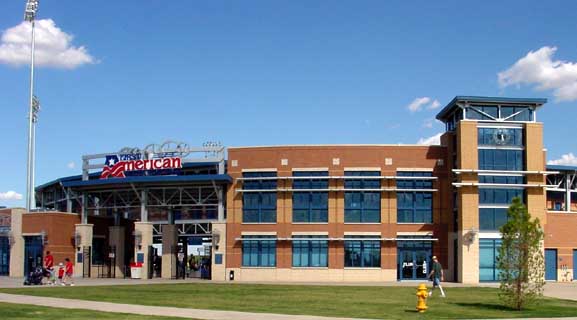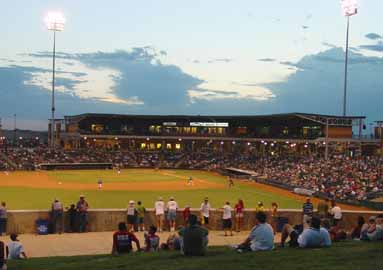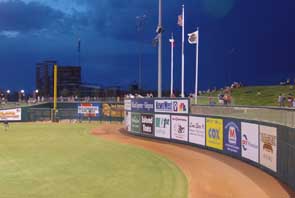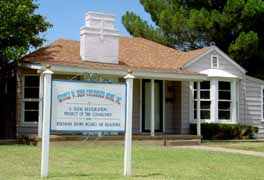Article and all photos by Joe Mock, BaseballParks.com
All rights reserved
When it came to new baseball parks, 2002 was an unusual year: no new Major League parks opened, which is rare, because during the 11-year stretch from 1991 through 2001, in only one year (1996) did no new MLB stadium open; and no fewer than eight opened in the affiliated Minors, far outdistancing the five that made their debuts in 2001.
That meant that the competition for BASEBALLPARKS.COM’s coveted Best New Park of the Year was pretty intense. At the Triple-A level, impressive new facilities opened in the downtowns of Fresno and Toledo. In full-season Class A ball, two cities in the Midwest League showed off new parks this year — Cedar Rapids and Peoria. In short-season baseball, Troy, NY, Casper, WY and Cal Ripken’s hometown of Aberdeen, MD opened long-awaited stadiums.
But the new ballpark that captured the fancy of BASEBALLPARKS.COM is the one in Midland, TX. That’s why the city’s shiny new First American Bank Ballpark was named the Best New Park of 2002!
KeySpan Park in Brooklyn, winner of the 2001 award, combined whimsical design elements with an incredible view of the Atlantic Ocean and a colorful amusement park. While none of the 2002 contenders offered such a novel combination, Midland’s new gem provides the fans of the Midland-Odessa area a first-class facility in which to watch their RockHounds of the Texas League. Let’s look at what makes First American so special.
 |
| The tower and brickwork of the exterior, set against the very blue Texas sky, is indeed an appealing look. |
Setting/Exterior
When Midland started planning for its sports-facility needs, it shunned the recent trend to drop a city’s new stadium downtown (and the trend has been to locate them in the area of downtown that’s not exactly the most desirable). Instead, since it needed the room for both a world-class football stadium — high-school football in Midland is nothing short of legendary — and a home for the pro baseball team, the city looked to the wide-open spaces in an undeveloped area west of town. Nevertheless, since this land sits right next to Loop 250, the city’s beltway of sorts, access to the complex is excellent. In addition, this location puts the stadiums in the part of Midland closest to the area’s other population center, Odessa (pop. 90,700), which is less than 20 miles due west of the complex.
The result was the Scharbauer Sports Complex, which includes the ballpark and a brand-new football/soccer/track stadium. Considering Midland’s smallish population of 98,000, this complex is quite an accomplishment, easily the envy of much larger metropolitan areas.
The look of the baseball park itself is beautifully complimentary to the football facility next door. The brickwork and classic entryway are similar to, but not exactly the same as, the gridiron palace across the parking lot. In this respect, HOK Sport, the architects, did their usual splendid job.
Interior
Frankly, the basic concept for the design of this park is being used over and over in the Minors: most of the seats on a lower level with a concourse at the top/rear; an upper level containing the press box and luxury suites (that typically offers a little overhang) and the ability to sit on a grassy hill beyond the outfield fences. So why is this better than, say, Peoria or Cedar Rapids?
 |
 |
| Whether on the grassy berm, in the $7 box seats or up in the luxury boxes, you can’t go wrong at First American. | Kudos for the spacious concourse, wide aisles and comfortable seating |
I felt the execution and the attention to detail were simply outstanding here. When you combine the beautiful aesthetics of the ballpark with the way it handles air flow (see below), it’s a winning combination.
The main seating bowl offers 100% theater-style seats, with no bleachers or benches here. Way to go! The color scheme is also quite nice, as the dark-blue seats are a welcome departure from the sea of green you see at most parks these days.
The main concourse is quite wide, and the access to food and concessions (a great souvenir shop, by the way!) is very good. Don’t underestimate the value of wide concourses, mind you. Round Rock’s Dell Diamond, the park that sets the standard for the Texas League, has walkways that are much too narrow — but maybe they never dreamed that over 660,000 Express fans would cram their way into that park season after season!
Extra-special features
If there are two inescapable facts about this part of Texas, they are: it’s really hot in the summer; and the wind never, ever stops blowing. Therefore, why not design a park that utilizes one element to address the other? In other words, the clever designers at HOK decided to permit the air to circulate very well around the main seating bowl. By making the entryways extra large, and avoiding obstructions between them and the stands, the incessant wind helps keep the fans cooler. This is also an element where the noted Dell Diamond, as wonderful as it is, is lacking. In addition, Midland’s upper deck, with its luxury suites and press box, is positioned so that most of the main seating bowl is in the shade for late-afternoon and evening games.
  |
Another fascinating feature of the park is the outfield wall. From the left-field foul pole to center field is a true adventure, as the wall juts out where the visitors’ bullpen is located, then curves in and out on its way toward center. Now, I’m not a big fan of contrived nooks and crannies that architects seem determined to put into the outfield fences in new parks these days (I think Minute Maid Park’s outfield wall is a joke, for instance), but the sweeping way in which this is done seems both appropriate and mesmerizing.
I also love the restaurant on the concourse level right behind home plate. At one of the games I attended here during the 2002 season, my son and I ate a wonderful meal there while watching the pre-game activities and first inning in air-conditioned comfort. And you didn’t have to have a “club pass” or be a season-ticket holder to eat there. Man, that’s livin’!
And I need to say a word about the ticket prices. Wow! If these aren’t the best value in baseball, then I don’t know what is! I love AA baseball, as I think the quality of play and the up-and-coming aspect of the young players (as opposed to AAA) make it the most enjoyable level of baseball there is. And to get to watch it in box seats, in a brand-new stadium, for only $7.00 is a wonderful bargain. The reserved seats are only $5.00, with kids costing only $4.00. The prices at the concession stands are reasonable, too, I thought.
Too often at ballparks, the sound from the PA speakers is so muffled that you can barely understand what the announcer is saying. Not here! The sound is wonderfully clear — although I didn’t think the pre-game hip-hop music was an appropriate fit with Midland, Texas, and I did find the deafening horn from an 18-wheeler, played after every RockHound run, to be annoying. It almost makes you wish that the opposing pitcher would throw a shut-out!
You know how antsy kids get at ballgames, and the RockHounds have several nice diversions for the young fans. There is a great playground above the berm in right center (Dad can easily watch the action while Junior climbs all over the playground equipment) and there are games and a clever moon bounce in left center.
Finally, the sun sets behind home plate here. That means that the outfield offers a wonderful view — and photo opportunity — of the setting sun behind the grandstand. Take a leisurely stroll around the outfield as the sun is setting for a beautiful view. And, I should add, you can walk completely around the field here, as there is what I like to call a 360-degree concourse, something all good ballparks should offer!
The local area
Now, I don’t want to make you think that Midland, Texas is a better vacation destination than the Grand Canyon or the Virgin Islands — although the baseball is better. But there are some things you can do in between RockHound games. This area of the Lonestar State is known as the Permian Basin, and it is rich in oil and natural gas. In fact, you’ll see those wells moving up and down simply everywhere. So, naturally, the Permian Basin Petroleum Museum is located in Midland, and it is worth seeing — although the kids might find it a bit more “educational” than “entertaining.”
 |
 |
| You can stop by the childhood home of our current President near central Midland | The RockHounds’ former home, windswept Christensen Stadium, can still be found on the northeast end of town |
You can also drive by the house where George W. spent his childhood years. When we were in town, it was being renovated so that it could be opened to the public.
If you’re a true ballpark buff, you’ll want to see the city’s 50-year-old park called Christensen Stadium, which sits right on Loop 250 northeast of downtown. It was always windy when the RockHounds were playing there, too. And if you’re a real baseball addict (I’m raising my hand, since I am one), you can make the hour-plus drive south of Midland to Big Lake, Texas. Why, you ask? Because Jim Morris, about whom the movie The Rookie was made, coached and taught at the high school there. To be honest, it is not worth the drive, since nothing about the town looks like anything in the movie, mostly because none of the movie was filmed here. There’s not even a plaque or sign at the high school’s ballfield commemorating the fact that Morris coached here.
Summary
The webmaster of BASEBALLPARKS.COM isn’t the only one who fell in love with this park. The fans of Texas’ Permian Basin region showed their devotion by purchasing lots and lots of tickets. In fact, the team shattered its old attendance record by more than 73,000!
So in a year with a great deal of competition (and Toledo provided an especially good challenge), Midland’s beautiful new facility has what it takes to be named BASEBALLPARKS.COM’s Best New Park for 2002.